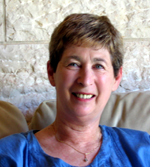By Dorothea Shefer-Vanson

MEVASSERET ZION, Israel –It was only after our father died, almost ten years ago, that my sisters and I could begin to tackle the daunting task of going through all the books, papers, and sundry objects that he and our mother had managed to accumulate in their roughly 20 years of life in Israel (after leaving Germany for England40 years earlier). It marked the start of a year in which the three of us met at least once a week in the evenings after work, to spend a few hours sorting through the things in their flat and deciding how to dispose of them. In retrospect, I find that it fulfilled a dual purpose, helping us to clear out the flat and aiding us in coming to terms with the finality of our loss.
Among the items we came across were our mother’s recipe books. These had been familiar objects in the kitchen ever since our childhood, first in our homes in London (Kilburn and Kingsbury), and later in their Jerusalem home. I for one had never looked inside the two small exercise-books, and upon glancing through them encountered a neat array of recipes, under several headings, in our mother’s calligraphic handwriting. When it came to deciphering them, however, we encountered the dual problem of the German language, of which we had only a limited understanding, and the nature of the handwriting, which was Gothic. There was no question of getting rid of those precious items, but what were we to do with them?
Our mother, who had attended cookery school in Berlin in the early 1930s, had been a superb cook, with baking as her special expertise. Her challot and rolls were renowned throughout the family as well as our parents’ circle of friends, and we were eager to ensure that those precious recipes should not be lost to future generations. Our children also pressed us to make them available to them. This was easier said than done, however, and initially the books had to be set aside until the clearing up and sale of the flat was completed.
Thus it was that about one year later, together with one of my sisters (the other one lived farther away and could not join us on a regular basis), I began weekly visits to a friend who was fluent in German and could decipher the Gothic script. The three of us would sit around her computer, the friend would read out the German, the three of us would discuss what the words might mean and with nimble fingers my sister would type the German into the computer while I hovered in the background, aiding and abetting. These sessions would last for a few hours each time, punctuated by coffee and cake, until eventually we would have to stop, our eyes and brains unable to take any more.
Eventually my friend moved away, fortunately only after the books had been deciphered. Then the work of translating the recipes began, first into English and then into Hebrew. This was also a major task, and involved a great deal of checking of quantities, conversion of weights from pounds to grams, and so on. My sister and I spent many hours on that project, which over time become almost a regular weekly meeting once we had both retired from our regular jobs. The coffee and cake continued to flow, of course.
Finally, a few months ago, we felt that it was ready. We had the book printed, adding an informative introduction as well as sundry family photographs. The resulting volume has been distributed to all her descendants as well as to friends and relatives. It seems to us to constitute a fitting memorial to our mother’s personality and life.
*
Shefer-Vanson, a freelance writer and translator based in Mevasseret Zion, can be reached at dorothea@shefer.com This article initially appeared in the AJR Journal, published by the Association of Jewish Refugees in the United Kingdom.